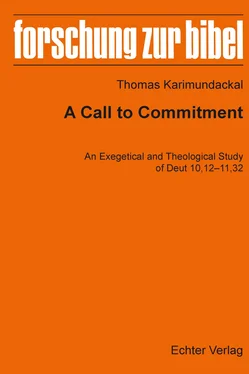136GESENIUS, Samaritanorum, 14, classifies the variant readings of the Smr under the following headings: 1) grammatical changes, 2) explanations in the text, 3) assumed changes in order to remove textual difficulties, 4) changes based on parallel passages, 5) expansion based on parallel passages, 6) harmonizing of chronologies, 7) Samaritan words and 8) sectarian readings based on Samaritan theology and cult practice. Interestingly, for these reasons Gesenius holds the view that the Smr is merely a corrupt edition of the Pentateuch based on a relatively late Jewish textual tradition, and he does not consider the Smr as a useful tool for text-critical studies. See also, PURVIS, Samaritan , 75 and WALTKE, Samaritan, 228-232. However, subsequent scholarship challenged Gesenius’ position and showed its significance for the textual criticism, cf. KAHLE, Untersuchungen, 399-439; ALBRIGHT, Early Recensions, 27-33; CROSS, Contribution, 278-292; TOV, Criticism , 80-100.
137According to HJELM, Samaritans, 93, “the common assertion that Samaritans expanded their texts with harmonizations of various sorts is unfounded because it has not been proven these additions meet any need of clarification.” I partially agree with Hjelm to the extent that every addition in the text does not clarify or explain the text. However, we can see the Smr’s tendency to harmonize the readings within Deuteronomy and in the Pentateuch. Variant readings of this unit illustrate this harmonizing pattern. See, TOV, Criticism, 85-89, who asserts the harmonizing tendency of the Smr. In his words, “The harmonizations in Smr reflect a tendency not to leave in the Pentateuchal text any internal contradiction or irregularity which could be taken as harmful to the sanctity of the text.”
138The question of the place of worship forms the focus of the alterations related to ideology. The Smr Decalogue (Exod 20,17b; Deut 5,18b) states that the Lord is to be worshipped on Mount Gerizzim. גריזים is used in all instances where Jerusalem is alluded to in the Torah, cf. TOV, Criticism, 95. The Smr’s tenth commandment mentions Deut 11,29a; 27,2b-3a. 4a. 5-7 and 11,30.
139Cf. TOV, Samaritan, ix; TOV, Criticism, 89-91.
140While 1QDeut asupports the singular version of the MT, 4QDeut chas a corrected plural version ברגליך. This shows clearly that the scribe of 4QDeut cknows about an authoritative text.
141The orthography of the Smr is characterized by the full use of internal matres, in contrast to the more restrictive orthography of the MT. The internal matres lectionis י and ו are extensively used and א is also sometimes used as an internal mater, cf. PURVIS, Samaritan, 54. According to TSEDAKA, Samaritan, xxix, among the ca. 6,000 differences between the Smr and the MT, approximately 50 percent of them are orthographic. See also ROBERTS, Text, 192; KAHLE, Untersuchungen, 402-410; WÜRTHWEIN, Text, 31.
142The differences may have arisen from various factors. Jobes and Silva suggest a few of them: 1) The Hebrew Vorlage from which it was translated was different from the Hebrew text extant today, 2) the translation process was unprecedented and therefore does not reveal a pattern, 3) the translator made a mistake, 4) the translator had an interpretative bias, 5) some complicated combination of these circumstances affected the resulting translation” cf. JOBES-SILVA, Septuagint , 92.
143Cf. TOV, Septuagint, 272.
144As JOOSTEN, Septuagint, 237, says “it is not always easy to decide at what stage harmonizations entered the text. In several passages, the harmonizations may already have existed in the Hebrew source text used by the translators.”
145The LXX reading seems to be appropriated as it alludes to the signs in Exodus (cf. Exod 7,3.9; 11,9.10).
146According to MCCARTHY, BHQ 82, the LXX treatment suggests a Vorlage with בוא.
147Since this verse is intrinsically related to 1,7 and Josh 1,4, OTTO, Deuteronomium , 1017, suggests the possibility of a homoioarkton as in 34,2.
148Cf. JOBES - SILVA, Septuagint, 22. See also, TOV, Exegesis, 215-233, to see how the LXX is influenced by the theology of the time of the translator.
149Cf. WEINFELD, Deuteronomy 1-11, 431.
150According to JOBES – SILVA, Septuagint , 93, “an element may be added to clarify or specify the thought, to harmonize the text with another biblical passage, or to make a historical or theological point”.
151According to Wevers, this change is intentional as it is not necessary to remind the Alexandrian Jews of their work in the past as agricultural slaves in Egypt and that in the present Egypt they have to cultivate their own land, cf. WEVERS, Notes, 192.
152Cf. OTTO, Deuteronomium, 1016.
153In Tov’s words, the LXX contains “more significant variants than all other textual witnesses together. Furthermore, apart from a few scrolls from Qumran, the LXX is the only source that contains a relatively large number of variants which bear on the literary criticism of the OT”, TOV, Use, 272.
154Tov’s identification of five text categories in the Qumran manuscripts may give some idea of the variant readings of the Qumran texts. According to him, the Qumran texts originate from: 1) the school of the Qumran scribes, 2) the protoMasoretic texts, 3) the pre-Samaritan texts, 4) texts close to the Hebrew Vorlage of the LXX and 5) non-aligned texts which exhibit no consistent patterns related to any one of these groups, cf. TOV, Criticism 114-16. However, as ULRICH, Scrolls, 84, notes, there are manuscripts that could be grouped into more than one category, at least for certain readings. See also his comments on the special Qumran practice and his elaborations on successive literary editions, cf. ULRICH, Editions 78-105.
155Tov has suggested that orthography can be a clue to knowing whether a manuscript was copied outside Qumran or at Qumran, cf. TOV, Orthography, 31-57; TOV, Manuscripts, 23-25. He also suggests a special orthographic system that reflects a special Qumran practice, TOV, Manuscripts, 25.
156The examples of the morphological and orthographical variations given below are only illustrative. Manuscripts like 4QDeut k1, 4QDeut cand 4QPhyl aare taken for this illustrative study.
157Cf. QIMRON § 100.51.
158Cf. MCCARTHY, BHQ, 80.
159However, the Qumran texts differ from the Smr as they add ואת כל־האדם אשׁר לקרח after ואת־אהליהם and not after ואת־בתיהם as in the Smr.
160Tov’s methodological observations for comparing the LXX with the Qumran scrolls will provide a basis for an adequate comparison of both the LXX with the Qumran texts. Some of his observations include: the reconstruction of the Vorlage of the LXX is tentative; only fragments have been preserved in the Qumran scrolls; the known statistics of the relationship between the LXX and the Qumran texts are incomplete; different types of readings common to the LXX and the scrolls must be distinguished; agreements in readings common to the scrolls, the LXX, and the additional sources are less persuasive than agreements shared only by the scrolls and the LXX; the generally accepted view of the relationship between the scrolls, the LXX and MT, and in particular the use of the term text-type, must be revised, cf. Tov, Scrolls, 45-67.
161Cf. JOOSTEN, Septuagint, 113-120, esp. 114. The agreement of the Qumran texts with the LXX and the Smr against the MT may also confirm the existence of Hebrew texts that differed from the MT. For example, there are passages in which the MT differs from the LXX, but the Qumran texts agree with the LXX. According to VANDERKAM, Scrolls, 127, “such instances are important for textual critics because they show that in these examples at least the Greek translators did not invent their variant readings. Rather, they were translating a Hebrew text that differed from the Masoretic Text.”
Читать дальше












